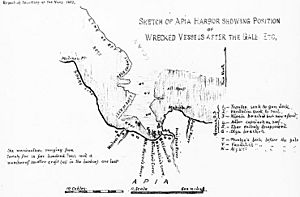Samoan crisis facts for kids
Quick facts for kids Samoan crisis |
|||||||
|---|---|---|---|---|---|---|---|
| Part of Samoan Civil War | |||||||
 The sketch features the locations of the wrecked German and American ships. |
|||||||
|
|||||||
| Belligerents | |||||||
| Commanders and leaders | |||||||
| Strength | |||||||
| 1 sloop-of-war 1 steamer 1 gunboat 200 marines |
3 gunboats 150 marines | ||||||
| Casualties and losses | |||||||
| 62 killed 1 sloop-of-war sunk 1 steamer sunk 1 gunboat grounded |
~73 killed 1 gunboat sunk 2 gunboats grounded |
||||||
|
|||||||
The Samoan crisis was a big disagreement between the United States, the German Empire (which was Germany at the time), and the British Empire (Great Britain). This happened from 1887 to 1889. They were all trying to gain control over the Samoan Islands during the First Samoan Civil War.
Contents
Why Samoa Was Important
In 1878, the United States got a place to refuel their ships at a harbor called Pago Pago. This harbor is on the island of Tutuila. In return, the U.S. promised to help protect Samoa.
Meanwhile, Germany also wanted a special area at the harbor in Apia. This harbor is on the island of Upolu. Both countries saw Samoa as an important spot in the Pacific Ocean.
The Standoff in Apia Harbour
The main event involved warships from the U.S. Navy and the German Navy.
- The U.S. Navy had three ships: the USS Vandalia, the USS Trenton, and the USS Nipsic.
- The German Navy also had three ships: the SMS Adler, the SMS Eber, and the SMS Olga.
These six warships faced each other in Apia Harbour for several months. It was a tense situation. A British ship, the HMS Calliope, was also there, watching everything.
The Great Cyclone
The standoff ended in a surprising way. On March 15 and 16, 1889, a huge storm called the 1889 Apia cyclone hit the harbor. This powerful storm wrecked all six warships that were stuck there.
The British ship, Calliope, was the only one that managed to escape the harbor. It bravely sailed out into the open sea and survived the storm.
After the storm, a famous writer named Robert Louis Stevenson came to Samoa. He wrote about the terrible event, even though he wasn't there to see it happen.
What Happened Next
Later, another conflict called the Second Samoan Civil War happened. Germany, the United States, and Britain were all involved again. In the end, they signed an agreement called the Tripartite Convention of 1899. This agreement split the Samoan Islands into two parts: American Samoa and German Samoa.
What We Learned
Historian Walter LaFeber said that this event helped some Americans realize how important it was for their country to have influence and power in faraway places like the South Pacific. It showed them that expanding their reach was a big deal.
Gallery
-
Wrecked vessels at Apia Harbour, Upolu, Samoa, during salvage efforts soon after the storm. The view looks about northward, with USS Trenton and the sunken USS Vandalia to the left and the beached German corvette Olga at right. The wreckage just off Trenton's stern may be from the German gunboat Eber, which was destroyed when she struck the harbor reef during the hurricane.
See also
- Samoan Civil War
- Second Samoan Civil War
- Siege of Apia
- German Samoa















